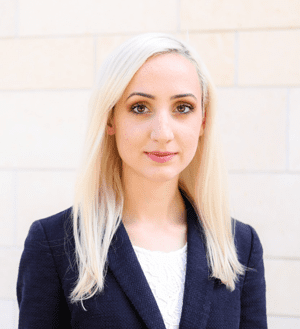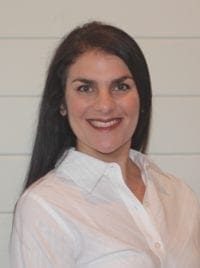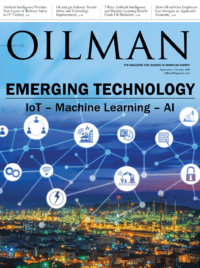Sarah Skinner: Can you tell me how Geosite got its start?

Rachel Olney: The idea for this company was many years in the making. I was fortunate enough to do a study for the Air Force years ago that gave me one of the best top level views of what was happening with commercial space and how it would impact other non-space industries, despite my academic focus in manufacturing. It ended up snowballing into a deep involvement with US Special Operations and an opportunity to help shape and advance innovation efforts happening across the Department of Defense. I got to spend a lot of time in some really intense places with some of the most capable people in our military. But deep down, I have always had a love for efficiency that was cemented in my time with heavy industry. When I heard that one of the teams I was working with had multiple casualties due to a process problem that could be solved with technology – technology I understood – I knew I needed to start Geosite.
SS: How would you describe Geosite’s capabilities?
RO: Geosite is a project management software for teams operating across the surface of the earth. Our application leverages the proliferation in satellite imagery sources and sensor systems to let organizations with distributed operations better coordinate and leverage assets (like people and equipment). Most humans are visual and Geosite is the platform that allows spatially distributed teams to communicate visually about their operations and to intuitively and collaboratively map operations. Geosite enables customers, from the U.S. Military to the energy industry, to use spatial data for more rapid and accurate planning and operations through intuitive workflows and collaboration tools.
SS: What led you to believe that there was a market out there for a different kind of geospatial software?
RO: There are two main compounding factors. First, before Geosite, software for spatial data was built solely for geospatial scientists. However, more than just engineers or scientists need to leverage this data to make smarter decisions to drive safety and efficiency. Because we select the best commercial and government data for our customers and have built a system that can ingest and translate data into an intuitive and visual tool, it takes out much of the learning curve and allows professionals with many different backgrounds and types of expertise to leverage technology. Second, there is simply more and more spatially referenced data – everything from updated imagery of the oil fields, to flood data and terrain. Organizations also want to see the data their own systems are producing, from production numbers to GPS trackers. I see E&P companies looking at 12 different pieces of software just to stitch together a cohesive picture of what is happening in the field rather than seeing a holistic picture, which leads to extremely costly and dangerous mistakes.
SS: How can access to this kind of data benefit companies?
RO: With the digitization of the oil field, E&P companies have more data from tracking and monitoring systems than they can intelligently incorporate into their operations. Geosite visualizes this data, allowing organizations to decrease time and labor effort in the field and increase safety through management by exception. Additionally, the project-based communications on Geosite’s platform allow your team to connect with services companies and contractors on specific projects – especially because our pricing is not per-seat. Lastly, Geosite gives E&P companies a collaborative, easy to use mapping environment. The ability to visually communicate decreases logistics delays and access to daily and high resolution satellite imagery that lets your team see what is happening in the field. Geosite’s data library also serves flood and environmental data – the ability to easily incorporate this information into planning helps increase safety and decrease risk.
SS: Have you seen much of a demand for your product in the oil and gas industry?
RO: The response has been incredible because many of our customers didn’t even know what we had built was possible – or even that the technology and data exists, especially on the space side. Many oil and gas companies have trouble knowing the conditions in the field without physically sending someone out to check. This is costly in many ways, including time and personnel, and it also generates more risk. Geosite provides the most up-to-date and highest resolution satellite imagery available, which allows operators to conduct desktop recon. Even more importantly, many oil companies have started investing in collecting more and better data, but few have seen this affect their bottom line because the software to integrate this information into their daily processes did not exist. Geosite answers this problem by linking this data into the right software to leverage the information across the enterprise.
SS: How can it be beneficial to oil and gas E&P companies?
RO: Few companies can realize gains from satellite and sensor data because they can’t integrate data and analytics into their business operations. In fact, creating a simple map of company assets usually requires advanced training and creates a bottleneck in the decision-making process. Geosite solves this problem by connecting executive, project management, and workforce teams to world-class satellite imagery and real-time sensor data in automatically updated maps. While projects are completed, users can view and edit project maps and data in real time. Teams with different roles can view or add comments to make it easier and faster to communicate. Executives can easily review project summaries and maps; project managers can track project status in real time and create work orders; and workers can use spatial data and tags for daily tasks.
SS: How can you get your name out to these companies and let them know that there is satellite data out there other than Google?
RO: When I first started talking to people in the oil and gas industry about Geosite, I assumed that they knew there was data they could leverage but just didn’t have access to. However, this turned out to be a false assumption. In hindsight, it makes sense that they wouldn’t know what is available – I had the “curse of knowledge” and assumed people knew what I knew. Yet, I spent years learning about the space and geospatial industries. We actually ended up shifting some of the features of Geosite to ensure our customers would not need to come up the steep learning curve of the geospatial industry. Ultimately, the major focus for any company is the needs of its customers. When we communicate how we solve real problems facing the oil and gas industry, our customers understand how they can leverage our technology. It’s never just about the technology itself.
SS: You’ve spoken about Geosite being more simplified and user friendly. What kind of in-depth training would a company be looking at for their personnel once they purchase the software?
RO: We built our platform so that anyone, regardless of background, could use it – not just GIS experts. It should not take more than 10 minutes to explain the full functionality of our platform, which is very different than geospatial software from the past decade. So there is no training required. We pride ourselves on this point because training and onboarding often become large barriers that keep businesses from using new software. However, unlike most software marketed towards enterprises, and more like the types of applications consumers are used to, Geosite is extremely intuitive, and as we get feedback for certain tools to incorporate more depth and complexity, we will make sure those tools remain self-explanatory.
SS: What is Geosite looking toward for the future?
RO: Geosite is currently working towards the integration of more sensor data (GPS and SCADA) so that users can track asset locations and status anywhere in the world. With the digitization of the oil field, we are working closely with sensor companies that are creating exquisite sensors, data, and analytics to help increase efficiency, accuracy, and safety. For instance, Reservoir Data Systems is doing some incredible things creating and analyzing data during completion. Because my background isn’t in oil and gas I love connecting with these kinds of experts that are truly pushing the envelope and deeply understand the industry. Moreover, it is the creation of all of this incredible data that drives Geosite’s thesis for project management software that lets diverse teams leverage better data. In the short term, we are also excited to work really closely with our first major oil and gas customers and adapting Geosite to meet all of their needs.
Rachel Olney is the Founder and CEO of Geosite Inc. Her academic research at Stanford focused on innovation in bureaucratic and hierarchical organizations as well as mechanical and systems engineering and design. Rachel also informed future planning for the military’s actions to leverage commercial imagery and communications platforms to create improved intelligence products and resilient planning and operations systems. Her company, Geosite, is backed by the top Venture firms in Silicon Valley, including YCombinator.
Sarah Skinner is a graduate of Louisiana State University with a degree in English. She has been a technical writer and editor in the oil and gas industry for over ten years in Houston and in Louisiana. She currently works as a technical writer for a pre-cast concrete construction company in Louisiana that builds blast-proof buildings for petrochemical plants.







